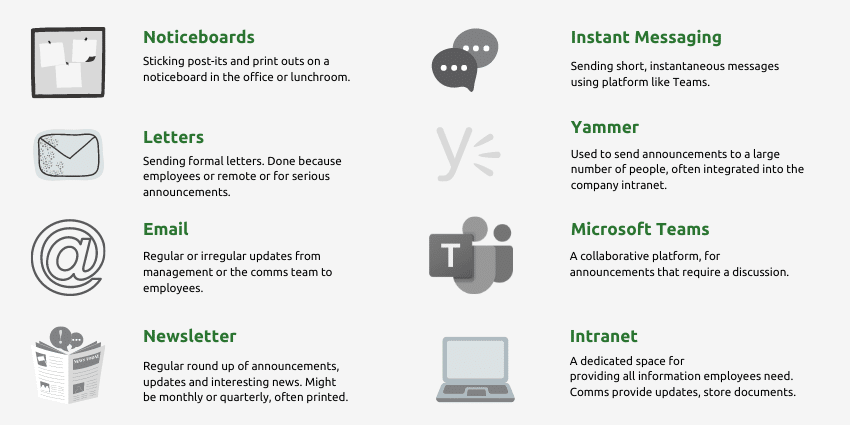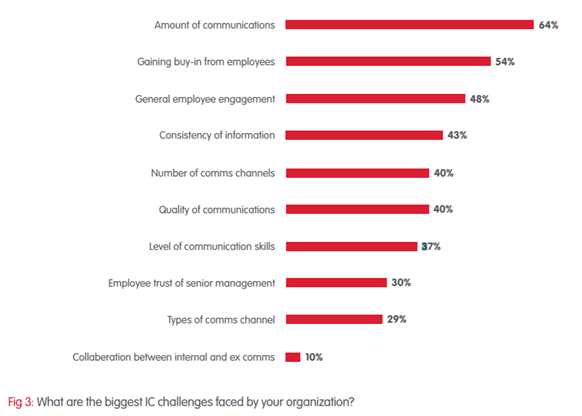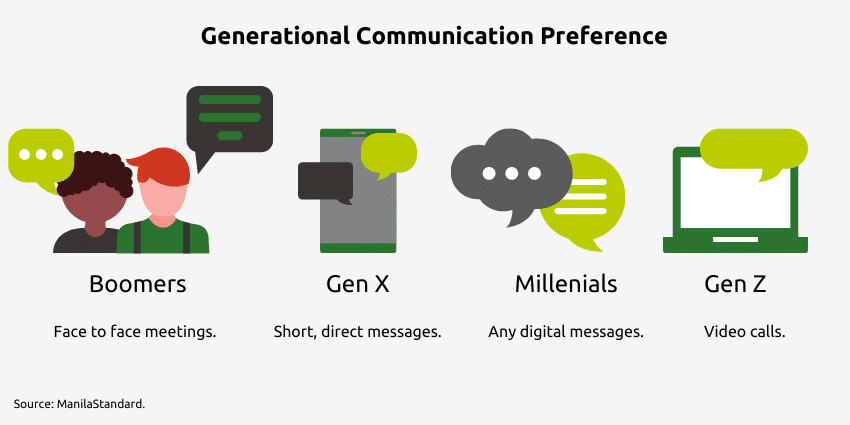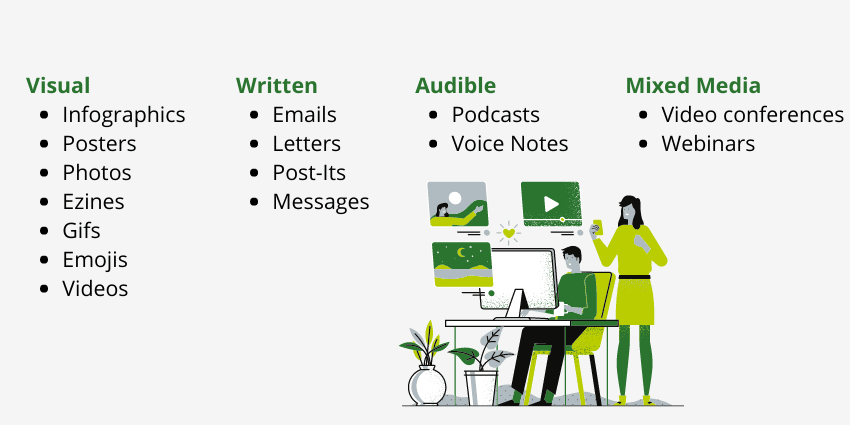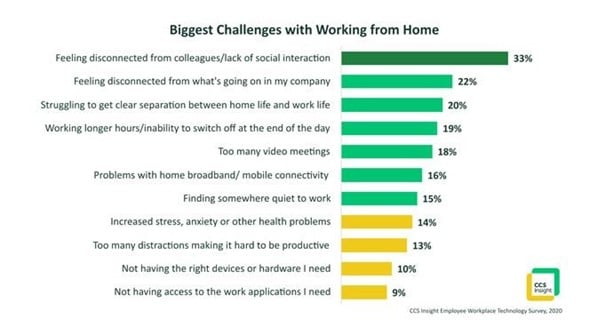What is internal communication?
Internal communication generally means any information shared in a company for business purposes. The term often refers to a person or department responsible for employee communications. They inform and engage with employees, providing company objectives and strategy updates. The need for a dedicated internal communications department is evident in large organizations, while in smaller companies, the task often falls to managers or HR.
Reasons to invest in and improve internal comms
Increased employee engagement
76% of internal communications professionals cite employee engagement as their top priority.
Internal communications departments ensure everyone is on the same page, working towards the same goal. At a broader level, internal comms managers are a driving force behind employee engagement. Aligning everyone around common goals boosts employee connections that are essential to creating an engaged workforce.
Helps employee advocacy efforts
Creating a positive internal dialogue is crucial to promoting positive external dialogue. Employees are a company’s best brand advocates. While employee advocacy might be more beneficial to HR and marketing, it starts with internal comms. Staff can’t be expected to talk about the organization if they don’t know what’s happening. Fortunately, the right internal communication tool and strategy can help.
A more inclusive, connected workforce
People can disconnect and leave when they feel left out of the conversation. Remote workers are especially vulnerable. Traditional internal comms strategies exclude those working from home, leaving them isolated. Now, in a hybrid work world, employees are split between home and the office. Ensuring that everyone has consistent communication is essential to company growth and success.
Employee communication is a far-reaching task with endless information possibilities. It’s also a very visible role, meaning the pressure is always on!
Want to improve your internal communications strategy and take it to the next level? Here are 13 easy steps.
Key challenges in internal communications
In this section, we’ll explore key challenges in internal communications and strategies to overcome them. From transparency issues to cultural differences, we’ll optimize communication for our workforce.
Lack of transparency
Employees often feel disconnected from the decision-making process and are unaware of important updates or changes. This lack of transparency can lead to frustration and disengagement among the workforce. As internal communication managers, it’s crucial to address this challenge by implementing strategies that promote open and honest communication.
Inefficient communication channels
With the multitude of tools and platforms available today, it’s easy for information to get lost or overlooked. This can result in critical messages not reaching the intended audience or employees feeling overwhelmed with excessive communication. To overcome this challenge, we must streamline communication channels, ensuring that information is delivered to everyone in the organization.
Cultural and generational differences
In enterprises with diverse workforces, we must be mindful of how different cultures and generations prefer receiving information. What resonates with one group may not have the same impact on another. Adapting our communication strategies to cater to these differences is essential, as well as promoting inclusivity and ensuring everyone understands our messages.
Want to improve your internal communications strategy and take it to the next level? Here are 13 easy steps.
13 internal communications strategies for engagement
1. Evaluate available tools
An internal comms strategy often depends on the tools available. In small businesses, there are limited ways of getting information to people, while in larger companies, the number of tools can be overwhelming.
Here are just some of the employee communication tools available:
Before making any improvements or changes, first, make a list of what channels are used. Does the business rely on email, maybe notice boards, or is there a more sophisticated system in place like an intranet?
2. Analyze the effectiveness of current efforts
Every business has an internal communications process, whether formalized or not. Even when a proper strategy has existed for a long time, there’s always room for improvement.
So after making a list of what’s available, analyze how effective the channel is by giving each a score from 1 to 10. If everyone missed the latest email, it probably deserves a low score.
Old habits can be hard to break. Just because comms has been sending a monthly email for the past decade doesn’t mean it’s worth sticking with.
3. Understand what people think of current efforts
Over half of internal communications professionals have a problem gaining employee buy-in. Perhaps it’s because the messaging or the communication channels don’t resonate with them. Maybe employees don’t understand the purpose or benefits for them.
Including employees in an effort to improve internal communications will be important for long-term success. Asking employees whether they got the latest mail will help evaluate channels and engage them in efforts.
4. Engage with employees: how do they want to communicate?
Everyone communicates differently. Some employees only send emails, while others prefer hosting meetings. Often it’s a personal preference, or it can depend on what’s available internally.
Generational differences also play a part. Gen Z and millennials are notorious for hating phone calls.
An effective internal communications strategy will need to use a few channels, but before wasting time sending emails that no one will read, make sure you know your audience.
This discovery stage can be informal, involving discussions with colleagues, or it can involve a more structured process to gather supporting data.
If the company uses Microsoft Teams, why not start a poll or send a survey?
5. Avoid one-way communications
It can be easy to fall into the trap of top-down communication. Too much focus on making sure employees receive information can be problematic. While it means everyone is on the same page, it can quickly create a closed culture where input isn’t valued. The goal should be to engage with employees.
Top-down comms have their place, especially in a crisis. Overall though, encouraging employee participation, allowing input, and generating discussion is a better sustainable strategy.
6. Look at the type of content being shared
Everyone absorbs content in different ways. Some people like to read, others listen or watch. Visual content, like infographics and posters, might appeal to certain groups, while others prefer formal emails and written announcements.
The best internal comms strategy will provide a good mix of content shared using different channels.

Internal comms used to be about sending mass emails to all employees. They were long and uninspiring. Lost in crowded mailboxes, the information was sent but often not received.
Today’s generation of employees is used to consuming information in an easily digestible way. Fifteen-second videos, gifs, and emojis are light years away from text-heavy emails or post-its on a notice board.
The type of content shared often depends on the channels used. Some platforms, like the intranet, support both written announcements and visual content like infographics and posters. Microsoft Teams is also great for sharing videos, gifs, and emojis.
7. Leverage user-generated content
Creating content that employees resonate with can be challenging, and getting stuck looking for inspiration is easy. Let employees be involved in the process. Create a space where staff can share ideas, articles, videos, or links to interesting information.
An employee advocacy platform that lets employees easily suggest content is a great way to start building a more immersive internal comms program.
8. Make information readily available
- After putting lots of effort into creating content, the next step is ensuring everyone can find it. Ideally, content shared should be stored in a central location that is easily accessible to all.
- Some channels make this easier to achieve than others.
- Emails get lost in overflowing inboxes. Printed materials are stuffed in drawers. Notices are taken down.
- An intranet with a secure content management system provides a good solution. The internal comms team can ensure relevant documents are easily accessible on their intranet page.
- Microsoft Teams is also a good place to share documents that people can then work together on or give immediate feedback and start a discussion.
9. Encourage coffee break conversations, even remotely
Information passes most easily when colleagues chat more casually. So, another way to improve internal communications is to make sure people have a chance to come together.
Pre-Covid, meeting colleagues at the coffee machine was an everyday occurrence. Now, it’s something most people can only dream of. Social interaction with colleagues is the number one thing those working from home miss.
Luckily, technology can help bring the chance coffee break to the virtual world and reconnect with co-workers.
Powell Governance virtual coffee machine organizes short coffee break meetings on Microsoft Teams. Our algorithm chooses people at random based on their availability. When people can meet and interact, information is more naturally shared.
10. Focus on employees
A successful strategy focuses on employees. One way to improve internal communications is to highlight employee achievements and milestones.
Send shout-outs to people on birthdays, recognize work anniversaries, and send holiday messages.
11. Include workers from around the world
Managing internal comms for a global team can be challenging. Different time zones and languages require extra effort to navigate these barriers. Here are ten tips for effective communication in a global team.
12. Bring in some fun and creativity
Sometimes, internal comms are tasked with sending tough messages, like handling internal crisis communications.
Yet, not every message has to be serious. People are looking for positive moments in their workdays, and something like weekly quizzes could be a great way to provide these.
Check out this idea from Powell Softwares’ internal comms team.

13. Test new strategies & invest in new tools
The only way to know if something will work is to try it. Employees may say they love receiving emails, but if a new monthly newsletter isn’t being opened, it’s time to reevaluate. Testing different content formats and channels will help build a long-term strategy.
At the same time, if the right tools aren’t in place, the comms team will always face an uphill battle.
A notice board in HQ won’t be very effective in sending company-wide updates where there are a few hundred employees. An employee communications platform, like Powell Intranet, will better match the needs of a growing company.
How does improved internal communication impact business performance?
- Clear and transparent communication channels allow information to flow seamlessly, leading to enhanced collaboration, increased productivity, and better decision-making.
- Effective internal communication fosters a sense of unity and alignment among employees, enabling them to work towards shared goals and objectives.
- It reduces misunderstandings, conflicts, and errors from poor communication.
- Employees who feel informed and engaged are more likely to be motivated, satisfied, and loyal, leading to higher retention rates.
Ultimately, improved internal communication positively influences business performance by driving efficiency, productivity, employee satisfaction, and overall organizational success.
Steps to maintain effective internal communication
Regular reviews and feedback
Conducting regular reviews and gathering employee feedback is crucial to maintain effective internal communication. By seeking input, we can identify areas for improvement and address any concerns or challenges they may be facing. Regular reviews also allow us to assess and adjust the effectiveness of our communication strategies.
Ongoing training
Ongoing training is another important step. By providing employees with the necessary communication skills and tools, we can enhance their ability to convey information clearly to colleagues. Ongoing training can include workshops, seminars, or even online courses.
Celebrating successes
Celebrating successes is a powerful way to foster effective internal communication. Recognizing and acknowledging achievements boosts morale and creates a positive and supportive work environment. By celebrating successes, we encourage open communication, collaboration, and a sense of pride among employees. This, in turn, contributes to a culture of effective internal communication, where achievements are shared and recognized, and employees feel valued and motivated.
Conclusion
Improving internal communications is a vital investment for any organization.
Enhancing communication strategies can increase employee engagement, which drives productivity and fosters a positive company culture. Through effective internal communication, you empower employees to become brand advocates, both internally and externally, amplifying your organization’s reputation. Additionally, prioritizing inclusivity in your communication efforts ensures that all employees feel connected and valued regardless of location or background.
With the 13 actionable steps outlined above, you can enhance internal communication and drive business success. You can propel your organization forward by continuously reviewing and providing feedback, offering ongoing training, and celebrating successes.
With the support of tools like Powell Intranet, you can streamline communication processes and make information easily accessible to all. Let’s seize the opportunity to transform our internal communication strategies and unlock the full potential of our workforce.



